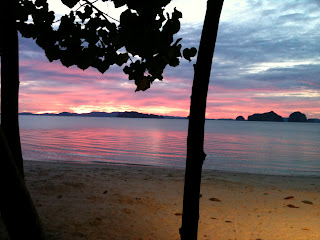 |
| Medium sized prawns, waiting to be grilled! |
The food experience in Thailand is a bit different than back in the States. Most Thai people eat "market food" or "street food", which is made by vendors who have their portable carts right on the sidewalks, or are in larger market stalls, all outdoors. The grocery stores here in Pattaya have only begun to carry western products in the last few years, and most items from the USA or Europe are heavily taxed and are quite expensive. For example, a box of Kellogg's or Post Raisin Bran here will cost about $285 baht, equivalent to about $9.50 US dollars. A tub of sour cream from the US costs $10 US. Cheese is also very expensive, because it is all imported. So, we try to buy local, or just decide that a box of Cheerios for $10 is something that we must have! Ice cream is another luxury item. A very small container of Haagen Dazs ice cream sells for about $10 US! We have learned to do without ice cream. Because of the location, seafood is readily available and very reasonably priced. Prawns are the most popular, and are sold in the whole form, heads and tails included! Sea Bass is also very popular and is used in fish and chip dishes locally. It is very inexpensive and is delicious! When we were looking for a place to live, we saw several condos that did not have ovens, because Thai people don't bake with ovens, several homes had "Thai kitchens" which were covered, outdoor cooking areas. We live in a "western style" home with an oven and no outside kitchen.
 |
| Pineapple, langsat, mangosteen, tangerines, oranges and rambutan (clockwise from the top) |
 |
| Fresh fruit from the local fruit stand |
Fruit is one area where the cost is flipped from back in the States. Because of the warm weather in Thailand, the growing season is year round, and the local fruits are very inexpensive. Pineapple farms surround Pattaya, and I can usually purchase two fresh pineapples for about $1.75 US. On many occasions, I will see a pick up truck filled with pineapples that are being sold right off the back of the truck on the street. A bag of 6-8 limes cost $1 US, a bag of passion fruit, which I absolutely love, cost $3 US; back in Michigan, one piece of passion fruit, when I could get the local market to stock it, would cost $3 US. I have bought a bag of mangos, tangerines and oranges for $100 baht, which is the equivalent of $3 US. Other incredible fruit here is the mangosteen, rambutan, langsat, lychee, pomelo, bananas, dragon fruit and papaya. The markets are filled with this beautiful fruit almost all year long and it is a bargain! I made several loaves of banana bread with bananas from my friend's banana tree, growing in her backyard. Once the banana trunk bears fruit, it dies off and is chopped down, to be replaced by a young shoot, growing along side the existing tree. Banana leaves are also used to wrap rice and noodle dishes.
 |
| Banana tree in my friend's back yard |
 |
| Pineapple farm, about 15 km from our house |
Most restaurants will have a western menu and a thai menu, western food is usually double the price of Thai food. One little restaurant that we frequent, located on the beach, has thin crust pizzas starting at $200 baht, and Phad Thai for $120 baht. Another expensive item to order or buy in Thailand is wine. The cheapest bottle of wine I have found is about $300 baht, and the average price for a decent bottle of wine is $500 baht, so if you have been keeping up with your conversions, that is nearly $17 for a very average tasting bottle of wine in the grocery story. No two buck chucks from Trader Joe's here! Wine is all imported and they add very high import taxes onto it, to boost the price up. In many grocery stores, they will not sell any alcoholic beverages from 2pm - 5pm, any day of the week. I haven't gotten a good answer for this one, other than they want to discourage the Thai people from drinking. Alcohol consumption is not encouraged by the Buddhist religion. The bars don't seem to have this limitation and will sell any time to any one. There are even bars on wheels, little vans that set up shop in town during the evening hours, and provide tables and chairs right on the sidewalks and serve drinks and play loud music out of their speakers. These "portable bars" are intended for the tourist trade, not the local population.
 |
| The "Cocktail Car" serving drinks right on the sidewalk in town. |
Starbucks is the one place that is the same at home as it is here, tables crowded with laptops and wireless devices, and lots of good, strong coffee. You can get a tall, grande or venti anywhere! Most restaurants in Pattaya serve espresso, it is very difficult to get a regular, brewed cup of coffee. When you order a cup of coffee you get one cup, no free refills, because each cup requires a new shot of espresso. McDonalds, Pizza Hut and Kentucky Fried Chicken all have a presence in Pattaya, and as they say in Thailand, "Same, same, but different". They look they same, but they aren't quite identical. In McDonalds you can order a "Rice with chicken" dish, right along with a Big Mac!


































